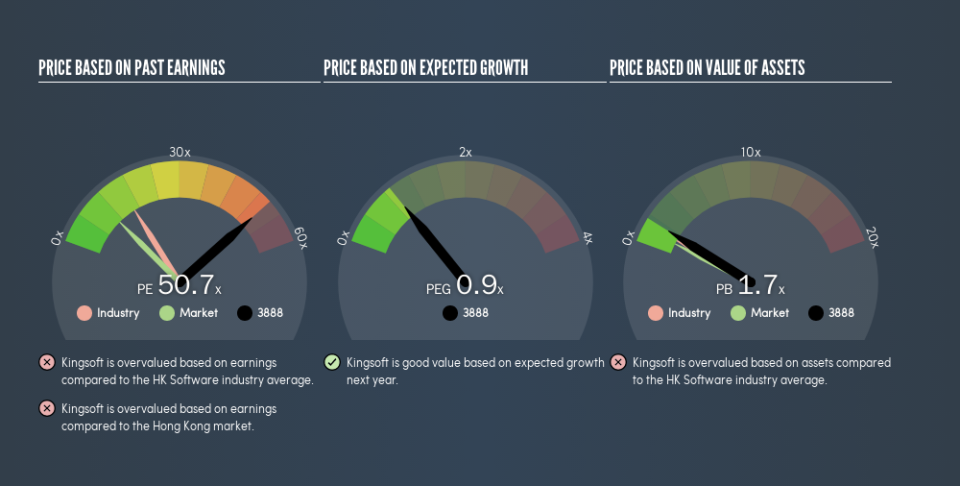Despite Its High P/E Ratio, Is Kingsoft Corporation Limited (HKG:3888) Still Undervalued?

This article is for investors who would like to improve their understanding of price to earnings ratios (P/E ratios). We’ll look at Kingsoft Corporation Limited’s (HKG:3888) P/E ratio and reflect on what it tells us about the company’s share price. Based on the last twelve months, Kingsoft’s P/E ratio is 50.67. That corresponds to an earnings yield of approximately 2.0%.
View our latest analysis for Kingsoft
How Do You Calculate Kingsoft’s P/E Ratio?
The formula for price to earnings is:
Price to Earnings Ratio = Share Price (in reporting currency) ÷ Earnings per Share (EPS)
Or for Kingsoft:
P/E of 50.67 = CN¥15.19 (Note: this is the share price in the reporting currency, namely, CNY ) ÷ CN¥0.30 (Based on the year to September 2018.)
Is A High P/E Ratio Good?
A higher P/E ratio means that buyers have to pay a higher price for each HK$1 the company has earned over the last year. That isn’t a good or a bad thing on its own, but a high P/E means that buyers have a higher opinion of the business’s prospects, relative to stocks with a lower P/E.
How Growth Rates Impact P/E Ratios
Probably the most important factor in determining what P/E a company trades on is the earnings growth. That’s because companies that grow earnings per share quickly will rapidly increase the ‘E’ in the equation. Therefore, even if you pay a high multiple of earnings now, that multiple will become lower in the future. A lower P/E should indicate the stock is cheap relative to others — and that may attract buyers.
Kingsoft’s earnings per share fell by 37% in the last twelve months. But over the longer term (3 years), earnings per share have increased by 37%. And over the longer term (5 years) earnings per share have decreased 16% annually. This might lead to muted expectations.
How Does Kingsoft’s P/E Ratio Compare To Its Peers?
The P/E ratio indicates whether the market has higher or lower expectations of a company. The image below shows that Kingsoft has a significantly higher P/E than the average (16.3) P/E for companies in the software industry.
Kingsoft’s P/E tells us that market participants think the company will perform better than its industry peers, going forward. Clearly the market expects growth, but it isn’t guaranteed. So investors should always consider the P/E ratio alongside other factors, such as whether company directors have been buying shares.
Remember: P/E Ratios Don’t Consider The Balance Sheet
Don’t forget that the P/E ratio considers market capitalization. That means it doesn’t take debt or cash into account. Theoretically, a business can improve its earnings (and produce a lower P/E in the future), by taking on debt (or spending its remaining cash).
Such expenditure might be good or bad, in the long term, but the point here is that the balance sheet is not reflected by this ratio.
Is Debt Impacting Kingsoft’s P/E?
The extra options and safety that comes with Kingsoft’s CN¥5.8b net cash position means that it deserves a higher P/E than it would if it had a lot of net debt.
The Verdict On Kingsoft’s P/E Ratio
Kingsoft’s P/E is 50.7 which is way above average (10.9) in the HK market. The recent drop in earnings per share would make some investors cautious, but the healthy balance sheet means the company retains potential for future growth. If fails to eventuate, the current high P/E could prove to be temporary, as the share price falls.
Investors should be looking to buy stocks that the market is wrong about. As value investor Benjamin Graham famously said, ‘In the short run, the market is a voting machine but in the long run, it is a weighing machine.’ So this free visual report on analyst forecasts could hold the key to an excellent investment decision.
You might be able to find a better buy than Kingsoft. If you want a selection of possible winners, check out this free list of interesting companies that trade on a P/E below 20 (but have proven they can grow earnings).
We aim to bring you long-term focused research analysis driven by fundamental data. Note that our analysis may not factor in the latest price-sensitive company announcements or qualitative material.
If you spot an error that warrants correction, please contact the editor at editorial-team@simplywallst.com. This article by Simply Wall St is general in nature. It does not constitute a recommendation to buy or sell any stock, and does not take account of your objectives, or your financial situation. Simply Wall St has no position in the stocks mentioned. Thank you for reading.

